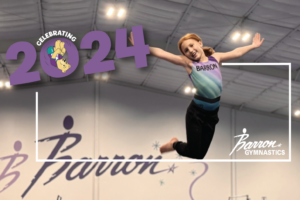I cannot remember a time when I was not involved in the sport of gymnastics. My mom was still demonstrating cartwheels for her students when she was pregnant with me! You could say that it is in my blood. I loved the challenge that gymnastics provided. My coaches taught me the great technique of setting goals by writing them down and focusing on bringing them to life. In my personal journey, I credit gymnastics with giving me the foundation for other sports, a love for fitness and movement, and a skill set that allowed for me to perform well in school and my professional life.
Now, as a gym owner, I am inspired when I see that same spark that I once felt in the eyes and smiles of the students at Barron Gymnastics. Here are five reasons why it is a great sport for children.
1. It is a Sport that benefits ALL Sports
Gymnastics provides a great foundation for ALL sports. Gymnastics develops strength, flexibility, balance, agility and coordination…all skills needed for sports like soccer, hockey, baseball, basketball, volleyball and football. The flexibility used to do a leg split is the same flexibility a hockey or soccer player uses to save a goal. The speed and running technique used to execute vault is the same power & quickness needed to sprint down a basketball court. The balance and coordination a gymnast develops to jump on a balance beam is similar to the skills needed by a pitcher on the baseball mound. Whether you become a competitive gymnast or participate in other competitive sports, gymnastics gives you a great foundation to succeed! Many gymnasts that have attended Barron have gone on to become the top pole vaulters and divers in the state and country due to their upper body strength, core strength and body awareness in the air.
2. It Teaches Persistence and Mental Toughness
Gymnastics is a sport where you fall again and again, and have to continually brush yourself off and get back up there. You may fall off the bars, but you always chalk back up and finish what you started. The sport teaches you the “power of yet”. Rather than conditioning oneself to say “I can’t do it”, it teaches you to say “I can’t do it YET”. This lesson is incredibly valuable not only in other sports, but also in life. You may not get the best score on the ACT or get your dream job on the first try, but if you have trained yourself on the “power of yet”, you will work even harder and go for it again. This resilient mentality will eventually pay off. Quitting is not an option.
3. Weather and Seasons are NOT a factor
Gymnastics is a year round sport so there is no need to wait until gymnastics season. As a result, you can participate year round or as it works in your schedule without worrying about the time of year. During your “off” season from other sports, taking gymnastics builds strength and coordination that will come in handy when you return to that sport. Whether rain or shine, hot or cold, the gym maintains a nice environment for every child to flip, twist, and move.
4. Social Skills and Life Lessons
Gymnastics teaches commitment, dedication, and builds confidence and self-esteem; all of these qualities breed success both in a child’s current stage as well as in the future. At Barron, we offer classes starting at 14 months old because we know that gymnastics is not just great for gross and fine motor skills, but it also can be great social preparation for starting school. Gymnastics requires kids to stand in line, take turns using equipment, and to listen to a teacher. It teaches a child to trust his or her teacher’s input and respect constructive feedback. Lastly, a child practices the art of focusing when remembering every detail that goes into a skill. For instance, they must remember “point my toes, arms straight, head neutral, tight core, straight legs” while flipping through the air. It is pretty incredible!
5. It Makes You Better at Writing, Math, & Reading
The strength kids build in their arms and hands improves their hand writing skills. The forward and backward movements or bilateral activities performed at gymnastics build visual and audio senses. These movements and activities also increase spatial awareness that helps develop math skills. Math is a spatial sport; the more that children move in different ways, the more connections are made in the brain to improve spatial awareness. When a child has good spatial skills, studies show that they have an easier time understanding math equations and geometric principles. Gymnastics and early childhood movement education is directly attributed to developing neurological pathways in students and promoting reading readiness. When a child walks sideways down the balance beam from left to right, they are training oneself on the same movement used in reading from left to right.




